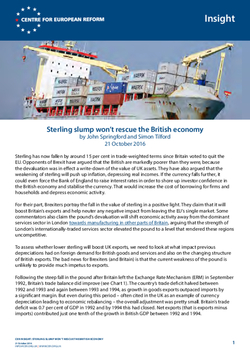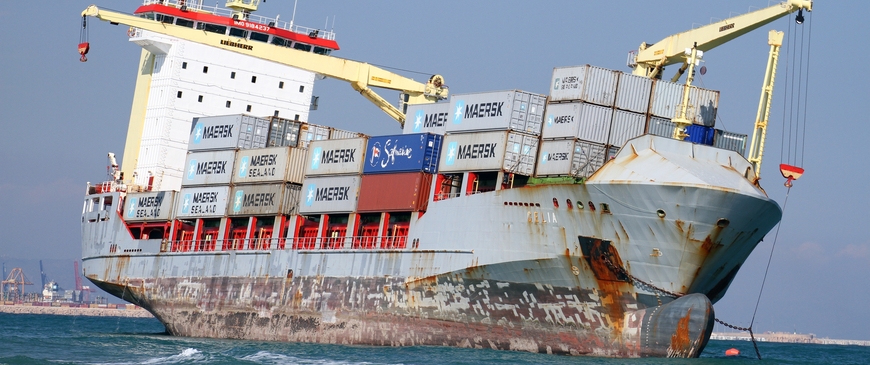
Sterling slump won't rescue the British economy
Sterling has now fallen by around 15 per cent in trade-weighted terms since Britain voted to quit the EU. Opponents of Brexit have argued that the British are markedly poorer than they were, because the devaluation was in effect a write-down of the value of UK assets. They have also argued that the weakening of sterling will push up inflation, depressing real incomes. If the currency falls further, it could even force the Bank of England to raise interest rates in order to shore up investor confidence in the British economy and stabilise the currency. That would increase the cost of borrowing for firms and households and depress economic activity.
For their part, Brexiters portray the fall in the value of sterling in a positive light. They claim that it will boost Britain’s exports and help neuter any negative impact from leaving the EU’s single market. Some commentators also claim the pound’s devaluation will shift economic activity away from the dominant services sector in London towards manufacturing in other parts of Britain, arguing that the strength of London’s internationally-traded services sector elevated the pound to a level that rendered these regions uncompetitive.
To assess whether lower sterling will boost UK exports, we need to look at what impact previous depreciations had on foreign demand for British goods and services and also on the changing structure of British exports. The bad news for Brexiters (and Britain) is that the current weakness of the pound is unlikely to provide much impetus to exports.
Following the steep fall in the pound after Britain left the Exchange Rate Mechanism (ERM) in September 1992, Britain’s trade balance did improve (see Chart 1). The country’s trade deficit halved between 1992 and 1993 and again between 1993 and 1994, as growth in goods exports outpaced imports by a significant margin. But even during this period – often cited in the UK as an example of currency depreciation leading to economic rebalancing – the overall adjustment was pretty small. Britain’s trade deficit was 0.7 per cent of GDP in 1992 and by 1994 this had closed. Net exports (that is exports minus imports) contributed just one tenth of the growth in British GDP between 1992 and 1994.

By 2007, Britain was running a sizeable trade deficit of 2.7 per cent of GDP. The devaluation of sterling during the financial crisis triggered by the September 2008 collapse of Lehman Brothers was greater than it had been in 1992: over 25 per cent between the third quarter of 2007 and the first quarter of 2009, compared with 14 per cent between the second quarter of 1992 and the first quarter of 1993. Despite this, the impact on Britain’s trade balance was much smaller. Britain’s trade deficit was actually higher in 2008 than 2007 and only improved moderately in 2009, standing at £35 billion compared with £39 billion in 2007. Net exports made a barely positive contribution to GDP growth between 2007 and 2009. By 2010 the deficit was higher than in 2007 despite the continued weakness of sterling.
Why was the reaction of trade to the depreciation of sterling more muted after the financial crisis than after sterling left the ERM; and what does this tell us about the likely trade response to the current period of sterling weakness? One major factor was the differing external environment between the two periods. Whereas the global economy, and in particular the European economy, grew strongly in the 1993-95 period, it did not in 2008-10. Crucially, the eurozone economy was smaller in 2010 than it had been in 2007.
Another factor that helps explain the differing export response to the two periods of currency weakness was the changing structure of British exports. Whereas in 1992 services accounted for little over a fifth of British exports, this proportion had risen to 35 per cent by 2007 (see Chart 2).
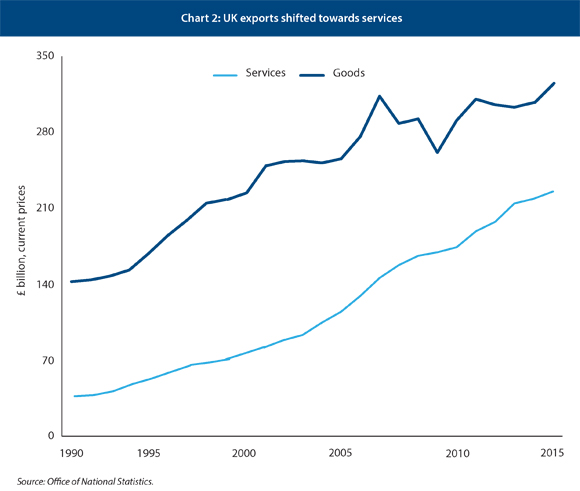
Between 1992 and 2007, the volume of goods exports rose only gradually, whereas the volume of financial services exports had risen six-fold and non-financial services three-fold (see Chart 3). With the exception of tourism (a cheaper pound makes Britain a more attractive place to visit), foreign demand for Britain’s high value-added financial and business services tends to be fairly insensitive to the price of those services. Cutting their price has less impact on demand than cutting the price of a low value-added manufactured good like a washing machine, or a low value-added service like tourism.
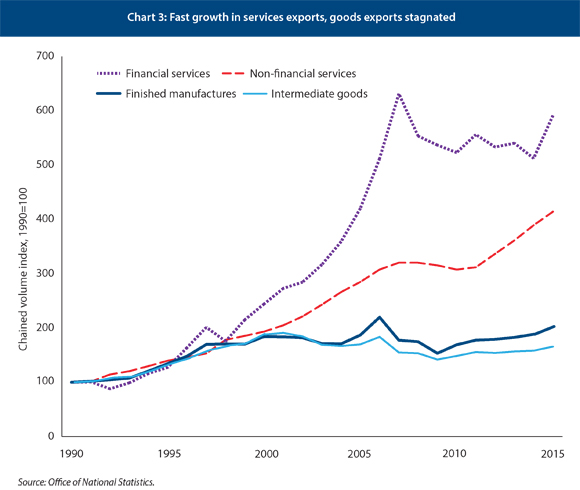
Another reason for the differing responses was the fall in the proportion of domestic value-added in British exports (see Chart 4). Between 1992 and 2007 Britain firms had become more integrated into pan-European supply chains, with the development of the EU’s single market. Foreign demand for intermediate goods and services is slower to respond to price changes than is demand for finished goods. The reason is that it takes time to switch suppliers from one country to another, and the demand for the intermediate product is largely determined by demand for the final good or service. For example, German manufacturers selling goods to China will often use UK-based firms for financial and legal services. If Chinese demand for the German firm’s goods falls, that lowers demand for British exports of financial and legal services. The value of sterling is a minor factor.
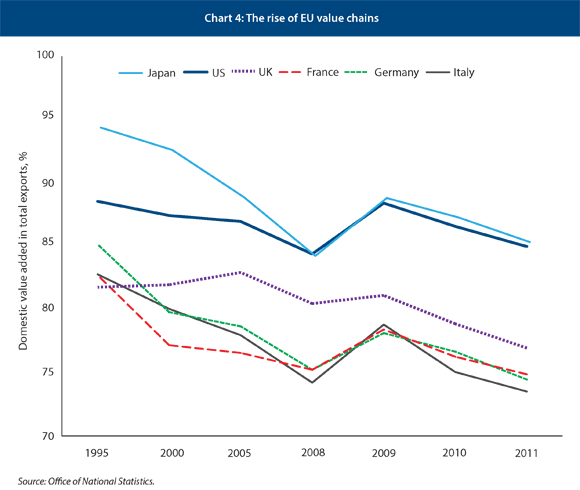
What does all this tell us about the likely trade effect of the latest fall in the pound? There is no doubt that the external environment now is more conducive to British export growth than it was in the immediate aftermath of the financial crisis. The eurozone is growing at around 1.5 per cent a year – less than the 1990s, but far better than in 2008-14. The US economy is also growing at 2 per cent a year. This, coupled with the pound’s depreciation, will raise demand for British exports, especially for travel and tourism in the UK.
But the demand for British exports is unlikely to grow quickly, even though British goods and services have become more competitive: global trade growth has slowed down since the financial crisis: in the 1992-2007 period, trade grew two times faster than GDP, but since then global trade has expanded in line with world economic growth. And global trade volumes have plateaued since the beginning of 2015. There are several explanations for this: the Chinese economic slowdown, rising protectionism, and the slowing rate of manufacturing offshoring to developing countries. Together, they mean that British exports are unlikely to grow quickly enough to ‘rescue’ the British economy.
#May's vow to end free movement & jurisdiction of ECJ over UK makes single mkt exit all but certain
What is more, since 2007, the composition of British exports has also shifted further in favour of services: services comprised 41 per cent of exports last year, up from 35 per cent in 2007. This has made Britain’s exports even more insensitive to exchange rate movements.
Finally, the spectre of Brexit will have a chilling effect on UK exporters’ investment, especially in services. Theresa May’s vow to end free movement and the jurisdiction of the European Court of Justice over UK courts makes a single market exit all but certain. The prospect of higher trade barriers, especially against UK services exports, may make companies leery of investing in extra capacity to satisfy higher EU demand for their exports.
Globalisation and the development of the EU’s single market have led the UK to specialise in services exports, many of which form part of EU supply chains. This has made the UK economy more efficient and raised GDP, but it has made British exports less sensitive to devaluations. The falling pound will not produce the export boom Brexiters hope for, while British consumers will become poorer as the price of imports rise.
John Springford is director of research and Simon Tilford is deputy director of the Centre for European Reform.

